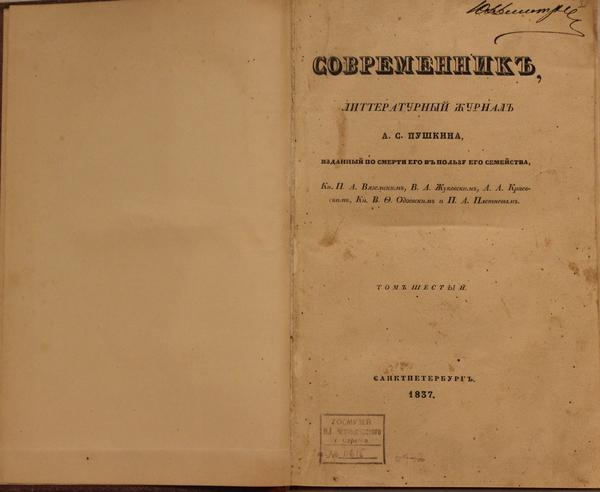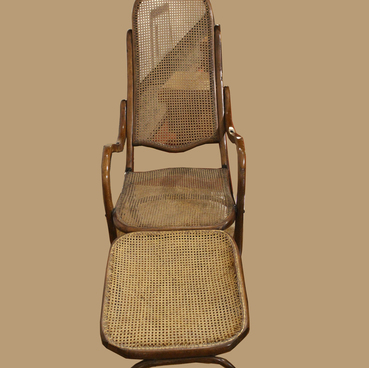Alexander Pushkin cherished the idea of establishing a journal for many years. ‘When will we take on a journal?! I awfully want it…’, wrote the poet to Pyotr Vyazemsky in August 1825. In December 1835, Pushkin sent to Alexander Benckendorff an application for the permit of a new publication. ‘I would like to start next year, 1836, publishing 4 volumes of purely literary, historical and scientific articles as well as critical analyses of Russian and foreign literature; like the English quarterly Reviews. Having withdrawn from all our journals I have also lost all my income. Publishing of such a Review would ensure my independence and, alongside with it, a way to continue the efforts I have started.’ The dream of publishing a journal came true, but not in full: ‘The Sovremennik’ was allowed as a purely literary journal only. Four volumes were issued in A.S. Pushkin’s lifetime.
After the death of A.S. Pushkin in winter of 1837, Zhukovsky obtained “an Imperial Permission” to continue the publication to the benefit of the poet’s children. He drew a preliminary plan of Volume 5 of the journal that came off the press in spring 1837. The larger part of the literary material had been earlier prepared by Pushkin himself. This is testified by the dates of the censorship authorization: the authorization date for both Volume 4 and Volume 5 is the same: 11 November 1836.
The publishers’ names on the cover are placed in the alphabetical order, while the leading role in the editorial board was played by Vassily Zhukovsky due to his experience and authority. The editorial board published in Sovremennik the works by Pushkin that had not been published in the poet’s lifetime. This made the journal widely popular: its circulation reached 2,000 copies.
The following works by Pushkin were published in Volume Six of Sovremennik: the translation of ‘Memoirs of Brigadier Moreau de Brasey on the Campaign of 1711’ with the introduction and notes by the poet, the unfinished drama The Mermaid and the novel The Moor of Peter the Great. The volume also contained the poem To Alexander Sergeyevich Pushkin by Pavel Katenin written and first published in 1828. One of the first publications by Mikhail Lermontov, the poem ‘Borodino’, also appeared in Volume Six.
Volume Six of ‘Sovremennik’ of 1837 from the library of Nikolay Chernyshevsky has an owner cover: the front and back cardboard covers with a leather backstrip are glued over with brown paper with small pimpled stamping. There is a signature of an unknown person on the title page.
After the death of A.S. Pushkin in winter of 1837, Zhukovsky obtained “an Imperial Permission” to continue the publication to the benefit of the poet’s children. He drew a preliminary plan of Volume 5 of the journal that came off the press in spring 1837. The larger part of the literary material had been earlier prepared by Pushkin himself. This is testified by the dates of the censorship authorization: the authorization date for both Volume 4 and Volume 5 is the same: 11 November 1836.
The publishers’ names on the cover are placed in the alphabetical order, while the leading role in the editorial board was played by Vassily Zhukovsky due to his experience and authority. The editorial board published in Sovremennik the works by Pushkin that had not been published in the poet’s lifetime. This made the journal widely popular: its circulation reached 2,000 copies.
The following works by Pushkin were published in Volume Six of Sovremennik: the translation of ‘Memoirs of Brigadier Moreau de Brasey on the Campaign of 1711’ with the introduction and notes by the poet, the unfinished drama The Mermaid and the novel The Moor of Peter the Great. The volume also contained the poem To Alexander Sergeyevich Pushkin by Pavel Katenin written and first published in 1828. One of the first publications by Mikhail Lermontov, the poem ‘Borodino’, also appeared in Volume Six.
Volume Six of ‘Sovremennik’ of 1837 from the library of Nikolay Chernyshevsky has an owner cover: the front and back cardboard covers with a leather backstrip are glued over with brown paper with small pimpled stamping. There is a signature of an unknown person on the title page.




